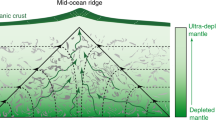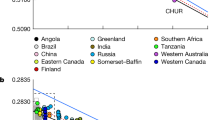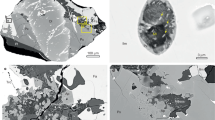Abstract
Water strongly influences the physical properties of the mantle and enhances its ability to melt or convect. Its presence can also be used to trace recycling of surface reservoirs down to the deep mantle1, which makes knowledge of the water content in the Earth's interior and its evolution crucial for understanding global geodynamics. Komatiites (MgO-rich ultramafic magmas) result from a high degree of mantle melting at high pressures2 and thus are excellent probes of the chemical composition and water contents of the deep mantle. An excess of water over elements that show similar geochemical behaviour during mantle melting (for example, cerium) was recently found in melt inclusions in the most magnesium-rich olivine in 2.7-billion-year-old komatiites from Canada3 and Zimbabwe4. These data were taken as evidence for a deep hydrated mantle reservoir, probably the transition zone, in the Neoarchaean era (2.8 to 2.5 billion years ago). Here we confirm the mantle source of this water by measuring deuterium-to-hydrogen ratios in these melt inclusions and present similar data for 3.3-billion-year-old komatiites from the Barberton greenstone belt. From the hydrogen isotope ratios, we show that the mantle sources of these melts contained excess water, which implies that a deep hydrous mantle reservoir has been present in the Earth's interior since at least the Palaeoarchaean era (3.6 to 3.2 billion years ago). The reconstructed initial hydrogen isotope composition of komatiites is more depleted in deuterium than surface reservoirs or typical mantle but resembles that of oceanic crust that was initially altered by seawater and then dehydrated during subduction. Together with an excess of chlorine and depletion of lead in the mantle sources of komatiites, these results indicate that seawater-altered lithosphere recycling into the deep mantle, arguably by subduction, started before 3.3 billion years ago.
This is a preview of subscription content, access via your institution
Access options
Access Nature and 54 other Nature Portfolio journals
Get Nature+, our best-value online-access subscription
$29.99 / 30 days
cancel any time
Subscribe to this journal
Receive 51 print issues and online access
$199.00 per year
only $3.90 per issue
Buy this article
- Purchase on Springer Link
- Instant access to full article PDF
Prices may be subject to local taxes which are calculated during checkout




Similar content being viewed by others
Data availability
All data used in this paper are included in the published article and its Supplementary Information and will be submitted to the EarthChem (https://doi.org/10.1594/IEDA/111310) and ResearchGate (https://www.researchgate.net/profile/Alexander_Sobolev) databases. Readers are welcome to comment on the online version of the paper.
References
Dixon, J. E. et al. Light stable isotopic compositions of enriched mantle sources: resolving the dehydration paradox. Geochem. Geophys. Geosyst. 18, 3801–3839 (2017).
Herzberg, C. Depth and degree of melting of komatiites. J. Geophys. Res. Solid Earth 97, 4521–4540 (1992).
Sobolev, A. V. et al. Komatiites reveal a hydrous Archaean deep-mantle reservoir. Nature 531, 628–632 (2016).
Asafov, E. V. et al. Belingwe komatiites (2.7 Ga) originate from a plume with moderate water content, as inferred from inclusions in olivine. Chem. Geol. 478, 39–59 (2018).
Shaw, A. M., Hauri, E. H., Fischer, T. P., Hilton, D. R. & Kelley, K. A. Hydrogen isotopes in Mariana arc melt inclusions: implications for subduction dehydration and the deep-Earth water cycle. Earth Planet. Sci. Lett. 275, 138–145 (2008).
Portnyagin, M., Almeev, R., Matveev, S. & Holtz, F. Experimental evidence for rapid water exchange between melt inclusions in olivine and host magma. Earth Planet. Sci. Lett. 272, 541–552 (2008).
Hartley, M. E., Neave, D. A., Maclennan, J., Edmonds, M. & Thordarson, T. Diffusive over-hydration of olivine-hosted melt inclusions. Earth Planet. Sci. Lett. 425, 168–178 (2015).
Jackson, M. G. et al. Ultra-depleted melts in olivine-hosted melt inclusions from the Ontong Java Plateau. Chem. Geol. 414, 124–137 (2015).
Bucholz, C. E., Gaetani, G. A., Behn, M. D. & Shimizu, N. Post-entrapment modification of volatiles and oxygen fugacity in olivine-hosted melt inclusions. Earth Planet. Sci. Lett. 374, 145–155 (2013).
Hauri, E. SIMS analysis of volatiles in silicate glasses, 2: isotopes and abundances in Hawaiian melt inclusions. Chem. Geol. 183, 115–141 (2002).
Puchtel, I. S., Walker, R. J., Touboul, M., Nisbet, E. G. & Byerly, G. R. Insights into early Earth from the Pt–Re–Os isotope and highly siderophile element abundance systematics of Barberton komatiites. Geochim. Cosmochim. Acta 125, 394–413 (2014).
Gurenko, A. A., Kamenetsky, V. S. & Kerr, A. C. Oxygen isotopes and volatile contents of the Gorgona komatiites, Colombia: a confirmation of the deep mantle origin of H2O. Earth Planet. Sci. Lett. 454, 154–165 (2016).
Andrault, D. et al. Deep and persistent melt layer in the Archaean mantle. Nat. Geosci. 11, 139–143 (2018).
Herzberg, C. & Asimow, P. D. PRIMELT3 MEGA.XLSM software for primary magma calculation: peridotite primary magma MgO contents from the liquidus to the solidus. Geochem. Geophys. Geosyst. 16, 563–578 (2015).
Robin-Popieul, C. C. M. et al. A new model for Barberton komatiites: deep critical melting with high melt retention. J. Petrol. 53, 2191–2229 (2012).
Bercovici, D. & Karato, S. Whole-mantle convection and the transition-zone water filter. Nature 425, 39–44 (2003).
Mibe, K., Orihashi, Y., Nakai, S. & Fujii, T. Element partitioning between transition-zone minerals and ultramafic melt under hydrous conditions. Geophys. Res. Lett. 33, https://doi.org/10.1029/2006GL026999 (2006).
Roberge, M. et al. Is the transition zone a deep reservoir for fluorine? Earth Planet. Sci. Lett. 429, 25–32 (2015).
Pearson, D. G. et al. Hydrous mantle transition zone indicated by ringwoodite included within diamond. Nature 507, 221–224 (2014).
Kamenetsky, V. S., Gurenko, A. A. & Kerr, A. C. Composition and temperature of komatiite melts from Gorgona Island, Colombia, constrained from olivine-hosted melt inclusions. Geology 38, 1003–1006 (2010).
Révillon, S., Arndt, N. T., Chauvel, C. & Hallot, E. Geochemical study of ultramafic volcanic and plutonic rocks from Gorgona Island, Colombia: the plumbing system of an oceanic plateau. J. Petrol. 41, 1127–1153 (2000).
Trela, J. et al. The hottest lavas of the Phanerozoic and the survival of deep Archaean reservoirs. Nat. Geosci. 10, 451–456 (2017).
Ohtani, E. Hydrous minerals and the storage of water in the deep mantle. Chem. Geol. 418, 6–15 (2015).
Walowski, K. J., Wallace, P. J., Hauri, E. H., Wada, I. & Clynne, M. A. Slab melting beneath the Cascade Arc driven by dehydration of altered oceanic peridotite. Nat. Geosci. 8, 404–408 (2015).
Chauvel, C., Goldstein, S. L. & Hofmann, A. W. Hydration and dehydration of oceanic-crust controls Pb evolution in the mantle. Chem. Geol. 126, 65–75 (1995).
Hofmann, A. W. The message from oceanic volcanism. Nature 385, 219–229 (1997).
Dhuime, B., Hawkesworth, C. J., Cawood, P. A. & Storey, C. D. A change in the geodynamics of continental growth 3 billion years ago. Science 335, 1334–1336 (2012).
Herzberg, C. Petrological evidence from komatiites for an early Earth carbon and water cycle. J. Petrol. 57, 2271–2287 (2016).
Hallis, L. J. et al. Evidence for primordial water in Earth’s deep mantle. Science 350, 795–797 (2015).
Kendrick, M. A. et al. Seawater cycled throughout Earth’s mantle in partially serpentinized lithosphere. Nat. Geosci. 10, 222–228 (2017).
Hofmann, A. W. Chemical differentiation of the Earth: the relationship between mantle, continental crust, and oceanic crust. Earth Planet. Sci. Lett. 90, 297–314 (1988).
Asafov, E. V. et al. Olivine-hosted melt inclusions in the ancient komatiites – the potential key to the Archean mantle composition. In ECROFI-2017 50 (2017); http://2017.ecrofi.univ-lorraine.fr/files/2016/03/catalogue-ecrofi-basseresolution2.pdf.
Pope, E. C., Bird, D. K. & Rosing, M. T. Isotope composition and volume of Earth’s early oceans. Proc. Natl Acad. Sci. USA 109, 4371–4376 (2012).
Hanski, E. & Kamenetsky, V. S. Chrome spinel-hosted melt inclusions in Paleoproterozoic primitive volcanic rocks, northern Finland: evidence for coexistence and mixing of komatiitic and picritic magmas. Chem. Geol. 343, 25–37 (2013).
Byerly, B. L., Kareem, K., Bao, H. M. & Byerly, G. R. Early Earth mantle heterogeneity revealed by light oxygen isotopes of Archaean komatiites. Nat. Geosci. 10, 871–875 (2017).
Wetzel, D. T., Hauri, E. H., Saal, A. E. & Rutherford, M. J. Carbon content and degassing history of the lunar volcanic glasses. Nat. Geosci. 8, 755–758 (2015).
Hauri, E. H. et al. Matrix effects in hydrogen isotope analysis of silicate glasses by SIMS. Chem. Geol. 235, 352–365 (2006).
Krasheninnikov, S. P., Sobolev, A. V., Batanova, V. G., Kargaltsev, A. A. & Borisov, A. A. Experimental testing of olivine–melt equilibrium models at high temperatures. Dokl. Earth Sci. 475, 919–922 (2017).
Sobolev, A. V. & Danyushevsky, L. V. Petrology and geochemistry of boninites from the north termination of the Tonga trench: constraints on the generation conditions of primary high-Ca boninite magmas. J. Petrol. 35, 1183–1211 (1994).
Danyushevsky, L. V., Della-Pasqua, F. N. & Sokolov, S. Re-equilibration of melt inclusions trapped by magnesian olivine phenocrysts from subduction-related magmas: petrological implications. Contrib. Mineral. Petrol. 138, 68–83 (2000).
Danyushevsky, L. V. & Plechov, P. Petrolog3: integrated software for modeling crystallization processes. Geochem. Geophys. Geosyst. 12, https://doi.org/10.1029/2011GC003516 (2011).
Ford, C. E., Russell, D. G., Craven, J. A. & Fisk, M. R. Olivine liquid equilibria: temperature, pressure and composition dependence of the crystal liquid cation partition-coefficients for Mg, Fe2+, Ca and Mn. J. Petrol. 24, 256–266 (1983).
Kareem, K. Komatiites of the Weltevreden Formation, Barberton Greenstone Belt, South Africa: Implications for the Chemistry and Temperature of the Archean Mantle. PhD thesis, Louisiana State Univ. (2005).
Ludwig, K. R. User’s Manual for Isoplot 3.75: A Geochronological Toolkit for Microsoft Excel. Special Publication No. 5 (Berkeley Geochronology Center, 2012).
Wendt, I. & Carl, C. The statistical distribution of the mean squared weighted deviation. Chem. Geol. 86, 275–285 (1991).
Acknowledgements
We thank S. Krasheninnikov for help in the heating of melt inclusions and V. Magnin for help with the EPMA facility at ISTerre, E. Füri for sharing with us reference synthetic forsterite and potentially H2O-free Suprasil 3002 quartz glass, and C. Bucholz and V. Polyakov for consultations on isotopic effects of hydrogen diffusion in olivine. The field work, business trips, participation in conferences, sample preparation and experimental study were funded by the Russian Science Foundation grant no. 14-17-00491 (to A.V.S.). Analytical work on EPMA facility in ISTerre was covered by Labex OSUG@2020 (Investissements d’avenir—ANR10 LABX56) and Institut Universitaire de France. The costs of SIMS analyses at CRPG, (Nancy, France) were covered by an INSU-CNRS grant to A.V.S. Maintenance of heating equipment in Vernadsky Institute was partially covered by Russian Foundation for Basic Research grant number 17-05-00856a (to A.V.S.). The additional study during revision of paper and publishing costs were covered by a grant from the Richard Lounsbery Foundation to A.V.S and E. Gazel. This is CRPG contribution no. 2702.
Reviewer information
Nature thanks Claude Herzberg and the other, anonymous, reviewer(s) for their contribution to the peer review of this work.
Author information
Authors and Affiliations
Contributions
A.V.S. designed the study, participated in sample collection, data processing and interpretation, and wrote the paper. E.V.A. participated in sample collection, found and prepared melt inclusions in olivines, conducted EPMA and SIMS analyses and participated in the data processing and interpretation. A.A.G. directed SIMS analyses and participated in data interpretation. N.T.A. and A.H.W. led the field work and sample collection, and participated in data interpretation and writing the paper. V.G.B. directed the EPMA analyses and managed EPMA facility at ISTerre. M.V.P. performed the laser-ablation ICP-MS analyses and participated in data interpretation and in writing the paper. D.G.-S. managed the laser-ablation ICP-MS analyses. G.R.B. guided sample collection. All authors discussed the results, problems or methods, and participated in preparation of the paper.
Corresponding author
Ethics declarations
Competing interests
The authors declare no competing interests.
Additional information
Publisher’s note: Springer Nature remains neutral with regard to jurisdictional claims in published maps and institutional affiliations.
Extended data figures and tables
Extended Data Fig. 2 Studied olivine-hosted melt inclusions.
Olivine-hosted melt inclusions (sample 1521) from the 3.3-Gyr-old Weltevreden komatiites. a, Untreated, partially crystallized melt inclusion containing clinopyroxene, glass and the shrinkage bubble. b–f, Glassy melt inclusions after the quenching experiments (see Methods): b, c and d contain shrinkage bubble; d contains fine olivine spinifex textures due to very high MgO contents of the melt (>26 wt% MgO); e and f, homogeneous melt inclusions; f, the 1521-9h melt inclusion reported in this study.
Extended Data Fig. 3 Calibration of standards for SIMS analysis.
a, H2O calibration line obtained for the series of reference glass standards (see Methods and Supplementary Information Table 4a, b) used to calculate H2O contents of the samples. b, c, The correlation lines between IMF and Al2O3 and H2O contents, respectively. A multivariant correlation between IMF and both H2O and Al2O3 contents (p < 0.002, R2 ≈ 0.75; equation (2), Methods) was used to correct the matrix effect of the analysed materials. R, correlation coefficient.
Extended Data Fig. 4 Reproducibility of IMF and δD of reference glasses.
a, Deviation of IMF of reference glasses from calculated values over the time of the analytical session. Lines with numbers represent linear correlations with correlation coefficient (R2). b, Deviation of IMF of reference glasses from calculated values over the analytical session time corrected for the apparent drift seen in a. c, Deviation of δD of reference glasses from accepted values over the analytical session time, corrected for apparent drift. Panels b and c are very similar but not the same. Grey shaded region, two standard errors; green shaded region, time interval of inclusion analyses. Error bars, two standard errors.
Extended Data Fig. 5 Significant correlation between isotope composition of H and size of melt inclusion in olivine of Weltevreden komatiites.
Inclusion 1521-ol12 (not shown) was excluded as a size outlier (120 μm).
Extended Data Fig. 6 Reconstruction of initial H2O contents in melt inclusions.
a, Al2O3 versus MgO of melt inclusions in olivine of Weltevreden komatiites. Alumina contents apparently follow olivine crystallization path of the initial komatiite melt calculated for 1521 sample32. b, Uncorrected (open circles) and corrected (filled circles) initial H2O contents of melt inclusions. Corrected initial H2O contents of melt inclusions follow olivine crystallization trajectory within each sample. All error bars reported as 1σ. ol, olivine.
Extended Data Fig. 7 The correlation of calculated initial δD of melt inclusions and measured Fo of host olivines for Weltevreden komatiites.
Obtained using the Isoplot 3.75 software44. The dashed line corresponds to best fit, and red lines delineate the error envelope of regression line at 95% confidence level. R, Pearson correlation coefficient. Error bars correspond to 2σ. a, Correlation for all 23 inclusions. Symbols marked red indicate inclusions that did not suffer significant H loss by diffusion. These inclusions fit the correlation within the error. Inclusions marked blue are apparent outliers and do not fit the correlation. b, Correlation for 20 inclusions, with three outliers (marked blue in a) filtered out. Large circle with dashed outline indicates estimate of initial δD of melt associated with the most Mg-rich olivine (Fo 96 mol%) of Weltevreden komatiites. The other large circles correspond to average initial δD for melt inclusions and host olivines of sample 1523 (orange outline), sample 1522 (green outline) and melt inclusions in measured most Mg-rich olivines (Fo > 95 ± 0.1, mol%) (red outline).
Supplementary information
Supplementary Tables
This file contains Supplementary Tables 1-4.
Rights and permissions
About this article
Cite this article
Sobolev, A.V., Asafov, E.V., Gurenko, A.A. et al. Deep hydrous mantle reservoir provides evidence for crustal recycling before 3.3 billion years ago. Nature 571, 555–559 (2019). https://doi.org/10.1038/s41586-019-1399-5
Received:
Accepted:
Published:
Issue Date:
DOI: https://doi.org/10.1038/s41586-019-1399-5
This article is cited by
-
Light oxygen isotopic composition in deep mantle reveals oceanic crust subduction before 3.3 billion years ago
Communications Earth & Environment (2024)
-
Earth’s early continental crust formed from wet and oxidizing arc magmas
Nature (2023)
-
Plate tectonics in the twenty-first century
Science China Earth Sciences (2023)
-
Deep mantle melting, global water circulation and its implications for the stability of the ocean mass
Progress in Earth and Planetary Science (2020)
-
Geochemical evidence for a widespread mantle re-enrichment 3.2 billion years ago: implications for global-scale plate tectonics
Scientific Reports (2020)
Comments
By submitting a comment you agree to abide by our Terms and Community Guidelines. If you find something abusive or that does not comply with our terms or guidelines please flag it as inappropriate.



